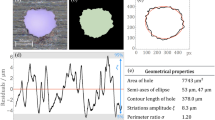Abstract
We describe a study of the laser drilling of stainless steel (SUS304) using a fiber laser with a wavelength of 1090 nm, assisted by intermittent gas jets. By comparing with the results obtained with the conventional continuous gas jets used in assisted laser drilling, we demonstrate that the use of the intermittent gas jets can effectively increase the material removal rate and reduce the consumption of assist gas. The intermittent gas jets can be modulated according to the frequency to effectively reduce the overcooling effect of the assist gas. Experimental results show that both the drilling depth and machining quality can be greatly and simultaneously improved. Two types of intermittent gas jets, namely, straight and swirling jets, are considered, and the effects of the intermittent frequencies and gas pressures on the laser drilling are investigated and discussed. We conclude that the intermittent gas jet method greatly reduces heat loss and slag formation around the hole exit in the laser drilling process. Compared with the results obtained when using a continuous straight gas jet, laser drilling with a 20-Hz intermittent straight gas jet reduces the drilled hole entrance diameter and increases the drilled hole depth by a factor of up to 1.7. The intermittent gas jet method can reduce the quantity of assist gas being used, and therefore the cost, especially when expensive gases such as helium and argon are being used.
Similar content being viewed by others
References
Biswas R, Kuar AB, Sarkar S, Mitra S (2010) A parametric study of pulsed Nd:YAG laser micro-drilling of gamma-titanium aluminide. Opt Laser Technol 42:23–31
Bandyopadhyay S, Gokhale H, Sarin Sundar JK, Sundararajan G, Joshi SV (2005) A statistical approach to determine process parameter impact in Nd:YAG laser drilling of IN718 and Ti-6Al-4V sheets. Opt Laser Eng 43:163–182
Kacar E, Mutlu M, Akman E, Demir A, Candan L, Canel T, Gunay V, Sınmazcelik T (2009) Characterization of the drilling alumina ceramic using Nd:YAG pulsed laser. J Mater Process Technol 209:2008–2014
Ghoreishi M, Low DKY, Li L (2002) Comparative statistical analysis of hole taper and circularity in laser percussion drilling. Int J Mach Tool Manuf 42:985–995
Low DKY, Li L, Corfe AG (2000) Effects of assist gas on the physical characteristics of spatter during laser percussion drilling of NIMONIC 263 alloy. Appl Surf Sci 154:689–695
Gurauskis J, Sola D, Pena JI, Orera VM (2008) Laser drilling of Ni–YSZ cermets. J Eur Ceram Soc 28:2673–2680
Kuar AS, Doloi B, Bhattacharyya B (2006) Modelling and analysis of pulsed Nd:YAG laser machining characteristics during micro-drilling of zirconia (ZrO2). Int J Mach Tool Manuf 46:1301–1310
Low DKL, Li L, Corfe AG, Byrd PJ (2001) Spatter-free laser percussion drilling of closely spaced array holes. Int J Mach Tool Manuf 41:361–377
Zhao K, Jia Z, Liu W, Ma J, Wang L (2014) Material removal with constant depth in CNC laser milling based on adaptive control of laser fluence. Int J Adv Manuf Technol. doi:10.1007/s00170-014-6481-4
Pastras G, Fysikopoulos A, Giannoulis C, Chryssolouris G (2014) A numerical approach to modeling keyhole laser welding. Int J Adv Manuf Technol. doi:10.1007/s00170-014-6674-x
Sezer HK, Li L, Leigh S (2009) Twin gas jet-assisted laser drilling through thermal barrier-coated nickel alloy substrates. Int J Mach Tool Manuf 49:1126–1135
Khan AH, Celotto S, Tunna L, O’Neill W, Sutcliffe CJ (2007) Influence of microsupersonic gas jets on nanosecond laser percussion drilling. Opt Laser Eng 45:709–718
Tse HC, Man HC, Yue TM (1999) Effect of magnetic field on plasma control during CO2 laser welding. Opt Laser Technol 31:363–368
Tse HC, Man HC, Yue TM (1999) Effect of electric and magnetic fields on plasma control during CO2 laser welding. Opt Laser Eng 32:55–63
Tse HC, Man HC, Yue TM (2000) Effect of electric fields on plasma control during CO2 laser welding. Opt Laser Eng 33:181–189
Bechtold P, Eiselen S, Schmidt M (2010) Influence of electrostatic fields and laser-induced discharges on ultrashort laser pulse drilling of copper. Phys Proc 5:525–531
Plechaty C, Presura R, Stein S, Martinez D, Neff S, Ivanov V, Stepanenko Y (2010) Penetration of a laser-produced plasma across an applied magnetic field. High Energ Dens Phys 6:258–261
Tsai DY, Lin J (2007) Characteristics of the plume particles removed by a swirling flow nozzle in laser ablation. Opt Laser Technol 39:219–224
Chen K, Yao YL, Modi V (2000) Gas jet–workpiece interactions in laser machining. J Manuf Sci Eng 122:429–438
Khan AH, O’Neill W, Tunna L, Sutcliffe CJ (2006) Numerical analysis of gas-dynamic instabilities during the laser drilling process. Opt Laser Eng 44:826–841
Chan CL, Mazumder J (1987) One-dimensional steady-state model for damage by vaporization and liquid expulsion due to laser-material interaction. J Appl Phys 62:4579–4586
Kar A, Mazumder J (1990) Two-dimensional model for material damage due to melting and vaporization during laser irradiation. J Appl Phys 68:3884–3891
Pastras G, Fysikopoulos A, Stavropoulos P, Chryssolouris G (2014) An approach to modelling evaporation pulsed laser drilling and its energy efficiency. Int J Adv Manuf Technol 72:1227–1241
Leitz KH, Koch H, Otto A, Schmidt M (2012) Numerical simulation of process dynamics during laser beam drilling with short pulses. Appl Phys A 106:885–891
Ho JR, Grigoropoulos CP, Humphrey JAC (1996) Gas dynamics and radiation heat transfer in the vapor plume produced by pulsed laser irradiation of aluminum. J Appl Phys 79:7205–7215
Ganesh RK, Faghri A, Hahn Y (1997) A generalized thermal modeling for laser drilling process—I. Mathematical modeling and numerical methodology. Int J Heat Mass Trans 40:3351–3360
Ganesh RK, Faghri A, Hahn Y (1997) A generalized thermal modeling for laser drilling process—II. Numerical simulation and results. Int J Heat Mass Trans 40:3361–3373
Dahotre NB, Harimkar SP (2008) Laser fabrication and machining of materials. Springer, New York
Author information
Authors and Affiliations
Corresponding author
Rights and permissions
About this article
Cite this article
Hsu, JC., Lin, WY., Chang, YJ. et al. Continuous-wave laser drilling assisted by intermittent gas jets. Int J Adv Manuf Technol 79, 449–459 (2015). https://doi.org/10.1007/s00170-015-6847-2
Received:
Accepted:
Published:
Issue Date:
DOI: https://doi.org/10.1007/s00170-015-6847-2



